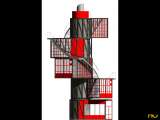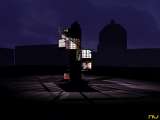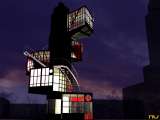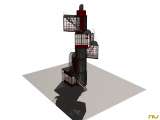
|

|

|

|

|

|
|
|
Edifici per al Leningradskja Pravda, plĂ nols |
|
El 1924 es va convocar un concurs per la construcciĂł dâuna torre pel LeningrĂĄdskaya Pravda (La veritat de Leningradâlâactual San Petersburg) a la capital de la UniĂł SoviĂštica. Lâespai disponible era mĂnim: un quadrat de 6 x 6m a la plaça StrĂĄsnaya (Strasnoy) âavui la plaça Pushkinâ ubicada sobre la traça del Bulevard Strasnoy, que limitava el segon i tercer anell de Moscou, i prop dâun dels carrers radials que connectava amb el kremlin. La privilegiada ubicaciĂł de la torre es similar a la triada per El Lissitsky per als seus gratacels horitzontals i estructures commemoratives i revela la intenciĂł propagandĂstica dâaquesta ocupaciĂł de les principals places de la ciutat amb manifestacions de lâart revolucionari. Per tant, no sorprĂšn el llistat dâarquitectes que es presenten al concurs: els germans Vesnin, Golosov, Ginzburg i el propi Melnikov, tots ells membres destacats de les files constructivistes. Utilitzant paraules del crĂtic formalista Victor Sklovsky, sâhaurĂ de veure, âla dissimilitud dâallĂČ que Ă©s similarâ per destacar els valors dâaquest projecte envers els altres, tots ells disposats a expressar els sĂmbols revolucionaris, el ritme nou de la ciutat, el clamor modernitzador. El projecte de Melnikov partia dâun nucli cilĂndric de formigĂł que allotjava una caixa dâescales de cargol i un ascensor. Entorn a aquest nucli, rotaven quatre mĂČduls dâacer i vidre, suspesos en voladĂs mitjançant unes guies i perfils metĂ lâąlics, una idea que repetirĂ en els croquis realitzats per al concurs del PavellĂł de Paris de 1925. La seva proposta semblava barrejar les idees presents tambĂ© a la proposta dels germans Vesninâ guanyadors del concursâ i de Golosov, com la incorporaciĂł del moviment âel tempsâ com un material nou per la arquitectura, els efectes de la transparĂšncia, o el formigĂł armat. PerĂČ mentre els Vesnin promovien la visiĂł del moviment vertical de lâascensor o la del cartell a la coronaciĂł de la torre, Melnikov semblava mĂ©s interessat en cercar la major varietat de posicions dâaquests mĂČduls mĂČbils i conseqĂŒentment, la infinita riquesa dâefectes i de llum en tot lâedifici. I si bĂ© utilitzava una estructura de formigĂł com Golosov, mentre que aquest modelava el material forçant-lo a adoptar complicades formes estrellades o cilĂndriques, Melnikov ho interpretava com un nucli encastat en el terreny per compensar lâesforç al que lâestructura seria sotmesa per la rotaciĂł dels forjats. (F.A.P.) |
|
Casa Melnikov
Club Rusakov Far de Colom PavellĂł de l'URSS |
|
Redibuixat i model interpretatiu realitzat per: 2005 - Javier Bas, Victor Gonzales Joan Sureda |
|
VV.AA.(con textos de Otokar MĂĄcel, Ton SalvadĂł, GinĂ©s Garrido, MoisĂ©s Puente, Federico Soriano et altri) Konstantin S. Melnikov. Madrid: Electa, 2001. VV.AA. Vanguardia SoviĂ©tica 1918-1933: Arquitectura realizada. Barcelona: Lunwerg Editors, 1996. COOKE, Catherine; KAZUS, Igor. Soviet architectural competitions 1924-1936. Londres: Phaidon, 1992. KHAN-MAGOMEDOV, Selim O. Pioneers of Soviet architecture. Londres: Thames and Hudson, 1989. KonstantĂn S. Melnikov. Madrid: Ed. Electa, Instituto de Juan Herrera, Escuela TĂ©cnica Superior de Arquitectura de Madrid, 2004. SALVADĂ, Ton (ed.), COHEN, J. L. COOKE, C. STRIGALER, A.A. TAFURI, M. Constructivismo Ruso. Barcelona: Ed. Del Serbal, 1994. |






